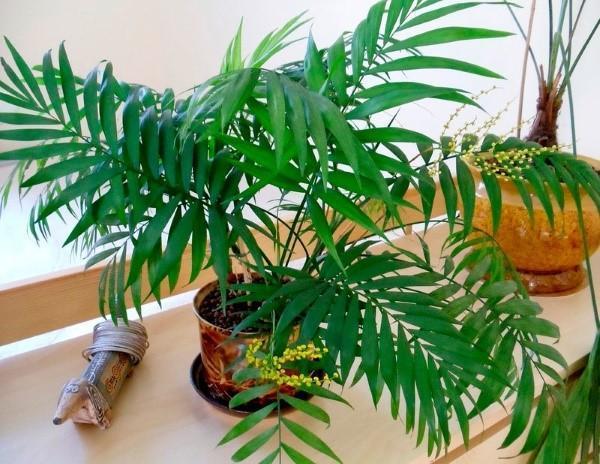Shade-tolerant hamedorea palm
 Most palms love good lighting, but there are some that do well in partial shade. First of all, this applies to the hamedorea or bamboo palm - a beautiful decorative flower that can adapt to any living conditions in an apartment.
Most palms love good lighting, but there are some that do well in partial shade. First of all, this applies to the hamedorea or bamboo palm - a beautiful decorative flower that can adapt to any living conditions in an apartment.
The bamboo palm has several varieties, but in indoor conditions the Neanta palm is most often grown (it is also graceful).
What is a plant?
The chamedorea palm belongs to thin-stemmed plants that have a bushy shape. The bush consists of many stems that turn into beautiful leaves. Their length reaches 40 cm, and the shape of the leaf plate is very delicate, feathery.
Blooming is no less beautiful palm trees, which occurs already at a young age. Among the leaves, a peduncle appears with delicate small inflorescences, collected in panicles and painted yellow. It looks a bit like mimosa.
In nature, the plant lives mainly in the shade of trees, due to which it has a shade-tolerant character. Under such conditions, it grows no more than 2 m in height, but as a tub culture it rarely exceeds 1.5 m.
Hamedorea is slow growing, so you should not expect a lush bush to form soon. But even at a young age, she looks very beautiful.
Read also about date palm!
What should you look for when buying a flower?
Going to a flower shop in search of an ornamental plant, you need to responsibly approach its choice:
- It is best to purchase a flower with bright leaves and new growth.
- You should not buy a palm tree if the leaves have yellow tips. This means that she is sick.
- You also need to bypass the lush, dense compositions of seedlings in one pot - they will dry out quickly. If they were nevertheless acquired, it is necessary to immediately plant the bush into parts in order to preserve at least one plant.
Care features
Hamedorea is one of those palm trees for which the brightness of the lighting does not matter. A shady corner in an apartment is even better suited for placing a pot than a place under the southern window, where direct rays will fall on the flower.
As for the temperature, it is important not to allow cold wintering (below 12 degrees Celsius) and in the summer to remove the tub from a stuffy room, in which it is above 23 degrees. At this time, it is better to take it out in the garden under a tree or on a summer veranda.
Hamedorea does not tolerate drafts and low temperatures, so you must remember to take her home before the cold snap.
Watering the flower should be moderate, not flooding it, but he loves spraying. In winter, the frequency of watering depends on the living conditions: the hotter it is in the room, the more often it is necessary to water and spray the palm tree so that the tips of the leaves do not dry out.
Since the growth processes of chamedorea are slowed down, in the first year it may not be fertilized. In the future, special preparations for palm trees are used for fertilizing, adding them every two weeks. It is necessary to nourish the palm tree even in winter, but not more often than once a month.